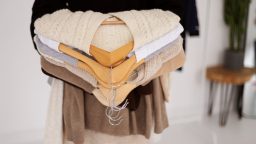As the weather changes, so should your wardrobe. Transitioning between seasons can be tricky, especially when it’s hard to predict whether the weather will be warm or cold from one day to the next. However, with the right approach, you can smoothly transition your wardrobe, keeping you stylish and comfortable without having to completely overhaul your closet each time the season shifts. Here’s how to make the most of your wardrobe during the transitional periods between seasons, so you’re prepared for anything.
- Layering is Key
One of the best ways to transition between seasons is through the art of layering. Layering allows you to adjust your outfit throughout the day as the temperature fluctuates, while still looking chic and put-together. For example, pair a lightweight sweater or long-sleeve top with a vest or denim jacket for cool mornings, and then peel off the outer layer as the sun warms things up.
In the autumn and spring, layers like cardigans, blazers, or light jackets are perfect for adding warmth without overheating. These pieces are versatile enough to layer over t-shirts, blouses, or dresses. A trench coat is also a stylish and practical outer layer for transitional weather, providing an added element of sophistication while still being lightweight enough for spring or fall.
- Mix Summer and Winter Pieces
One of the easiest ways to make your wardrobe work for both seasons is to mix summer and winter items. For example, you can take a summer dress and pair it with tights or leggings and ankle boots for a more autumnal look. Likewise, lighter fabrics like cotton or linen can be worn with a jacket or scarf to add warmth during the cooler months.
For example, take a summer sundress and add a cozy cardigan or chunky knit sweater over the top. This creates a stylish yet functional outfit that works for fluctuating temperatures. You can also try layering a long-sleeve shirt under a short-sleeve dress for a fresh look that feels seasonally appropriate.
- Switch Up Footwear
The right footwear can make all the difference when transitioning your wardrobe between seasons. While sandals and flip-flops are perfect for summer, as the weather cools, it’s time to swap them out for ankle boots, loafers, or even sneakers.
Ankle boots are particularly great for autumn and spring, as they can be paired with skirts, dresses, or jeans. Look for suede or leather options in neutral tones to ensure versatility. In the warmer months, closed-toe flats or stylish sneakers can give you comfort while still offering a stylish touch to your outfit. Depending on the day, you can easily transition from boots to flats or even wedges, depending on the temperature and your personal style.
- Opt for Transitional Fabrics
Fabrics play an important role in adapting your wardrobe to the changing weather. Lighter fabrics like cotton, linen, and silk are perfect for summer, but as the temperature cools, you’ll want to bring in thicker, cozier fabrics like wool, cashmere, and heavier knits.
However, for those tricky in-between months, aim for fabrics that are breathable yet offer some warmth. Medium-weight fabrics like jersey, denim, and lightweight knits are great choices. These fabrics can be worn year-round and allow you to build outfits that are comfortable for fluctuating temperatures. Look for wool-blend sweaters or cotton-blend jackets to maintain comfort and style throughout the transitional seasons.
- Add Accessories for Extra Warmth
Accessories can make all the difference when transitioning between seasons, especially when you’re not sure whether to go with a full winter look or a lighter, more summery vibe. A scarf, hat, or pair of gloves can add warmth to your outfit without the need for heavy outerwear. For instance, a chunky knit scarf can be added to a lighter coat or jacket to provide warmth when temperatures drop.
Another great transitional accessory is a wide-brimmed hat or beanie. Hats can work year-round, and they can add a stylish flair to any outfit, whether you’re wearing a light sweater or a heavier winter jacket.
- Incorporate Transitional Colours
When switching from summer to autumn or spring to summer, colour can help bridge the gap between the two seasons. Lighter shades, pastels, and vibrant colours are often associated with warmer weather, while deep hues like burgundy, mustard, and navy are favoured in cooler months. However, you don’t have to completely abandon bright colours or prints during the transitional period.
For instance, pairing a pastel blouse with a camel or olive green jacket creates a balanced look that’s perfect for the in-between months. Alternatively, light neutrals like beige, taupe, or blush tones can easily work in both seasons, providing a subtle transition that complements both the warmer and cooler elements of the changing weather.
- Transition Your Outerwear
The key to transitioning your wardrobe between seasons often comes down to your outerwear. For chilly mornings and evenings, lightweight jackets like denim jackets, leather jackets, or utility jackets are perfect for adding an extra layer of warmth without overheating. These jackets can be worn over summer dresses, t-shirts, or even sweaters, making them ideal for unpredictable weather.
As the weather cools even further, you can switch to heavier outerwear like a trench coat, pea coat, or wool-blend coat, which are all great transitional pieces. Just make sure to adjust the layering underneath to suit the temperature. For instance, wear a light sweater or long-sleeve shirt under a trench coat in the autumn, or layer a warm knit underneath a heavier coat when winter approaches.
- Keep Your Skin Hydrated and Your Makeup Lighter
Seasonal transitions also require adjusting your skincare and makeup routine. As the weather shifts, your skin can become drier, so it’s important to keep it hydrated. Use moisturisers that are rich and nourishing to avoid dryness, especially during the colder months.
When it comes to makeup, try switching from heavier foundations to lighter options like BB cream or tinted moisturiser. This will help you achieve a fresh, natural look that’s more suited to warmer temperatures, but still provides the coverage you need when transitioning into cooler weather.
- Bring Back Sunglasses and Sunscreen
Even when transitioning into autumn or spring, it’s important to remember that the sun can still be strong. Sunglasses and sunscreen are essential year-round accessories, especially in the transitional months when the sun can still be unpredictable. A chic pair of sunglasses can elevate any outfit while protecting your eyes, and applying sunscreen every day will keep your skin healthy and safe.
Conclusion
Transitioning your wardrobe between seasons doesn’t have to be difficult. By focusing on layering, mixing fabrics and colours, and adjusting your footwear and outerwear, you can seamlessly move from one season to the next while staying stylish and comfortable. Embrace versatile pieces, experiment with combinations, and pay attention to your accessories to help you adapt to the ever-changing weather. With these tips in mind, you’ll be able to master the art of transitioning your wardrobe and enjoy your favourite clothes throughout the year.





